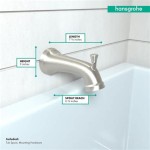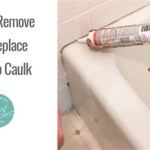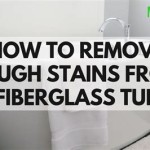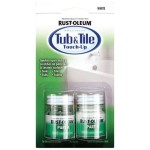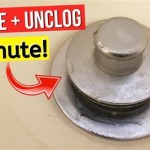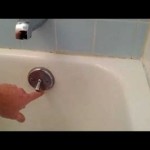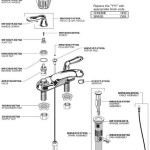How To Remove Corrosion From a Bathtub Drain
Corrosion of a bathtub drain is a common problem that can lead to restricted water flow, unpleasant odors, and even leaks. The presence of minerals in water, combined with the constant exposure to moisture and the chemical composition of cleaning products, accelerates the corrosion process. Addressing this issue promptly is crucial to maintaining the functionality and longevity of the plumbing system and preventing more extensive and costly repairs.
The process of removing corrosion from a bathtub drain involves several steps, each requiring careful attention to detail and the use of appropriate tools and materials. Depending on the severity of the corrosion and the type of drain, different methods may be employed. This article provides a comprehensive guide on identifying, assessing, and effectively removing corrosion from a bathtub drain, followed by preventative measures to inhibit future corrosion.
Identifying Corrosion on a Bathtub Drain
The first step in addressing bathtub drain corrosion is accurate identification. Recognizing the signs of corrosion early can prevent the problem from escalating and causing further damage. Common indicators of corrosion include visible rust-colored stains around the drain opening, a reduction in the rate at which water drains from the bathtub, and a foul or musty odor emanating from the drain. The drain stopper may also appear discolored or corroded, and the drain flange (the visible metal ring around the drain opening) may exhibit pitting or bubbling.
A visual inspection of the drain and surrounding area is usually sufficient to identify surface corrosion. However, more extensive corrosion may require a closer examination. This can involve using a flashlight to inspect the drainpipe from above or, in some cases, disassembling parts of the drain assembly to assess the extent of the damage. Any signs of rust, discoloration, or physical degradation of the metal indicate the presence of corrosion. Examining the drain components beneath the tub, if accessible, can also reveal corrosion along the pipes and connections.
It is important to distinguish corrosion from other types of drain blockage, such as hair or soap scum buildup. While these blockages can also impede water flow, they typically do not present with the characteristic signs of rust or metal degradation. Misidentifying the problem can lead to the use of ineffective solutions and potentially exacerbate the underlying corrosion issue.
Tools and Materials Required for Corrosion Removal
Before commencing the corrosion removal process, it is essential to gather the necessary tools and materials. Having everything readily available will streamline the process and minimize potential delays or complications. The specific tools and materials required will depend on the chosen method of corrosion removal, but the following list provides a general guideline:
- Safety Glasses and Rubber Gloves: Protecting the eyes and skin is paramount when working with cleaning chemicals and abrasive materials.
- Screwdriver: Various types of screwdrivers (flathead and Phillips head) may be needed to disassemble the drain assembly.
- Adjustable Wrench: An adjustable wrench is useful for loosening and tightening drain components.
- Wire Brush: A wire brush is effective for removing loose corrosion and scale from metal surfaces.
- Scouring Pad: A non-abrasive scouring pad can be used to gently scrub away surface corrosion without scratching the finish.
- White Vinegar: White vinegar is a mild acid that can help dissolve rust and mineral deposits.
- Baking Soda: Baking soda, a mild alkali, can be used in conjunction with vinegar to create a fizzing action that helps loosen corrosion.
- Commercial Rust Remover: For more severe corrosion, a commercial rust remover may be necessary. Ensure the product is safe for use on plumbing fixtures.
- Drain Cleaner: A drain cleaner can help clear any remaining blockages after the corrosion has been removed. Use with caution and follow the manufacturer's instructions carefully.
- Plumber's Putty: Plumber's putty is used to create a watertight seal when reassembling drain components.
- Clean Rags: Clean rags are essential for wiping away debris and cleaning surfaces.
The selection of the appropriate rust remover is crucial. Consider the material of the drain and its finish. Avoid using harsh chemicals that could damage the plumbing fixtures or the surrounding bathtub surface. Always read the product label and follow the manufacturer's instructions carefully. Additionally, ensure adequate ventilation when working with chemicals.
Steps for Removing Corrosion from a Bathtub Drain
The following steps outline a comprehensive process for removing corrosion from a bathtub drain. The process may need to be adapted depending on the severity of the corrosion and the type of drain assembly.
- Preparation: Begin by protecting the surrounding bathtub surface with a cloth or drop cloth to prevent scratches or damage. Wear safety glasses and rubber gloves to protect the eyes and skin.Ensure the bathtub area is well-ventilated.
- Disassembly (If Necessary): If the corrosion is extensive or located within the drain assembly, it may be necessary to partially disassemble the drain. Start by removing the drain stopper. Depending on the type of stopper, this may involve unscrewing it, lifting it out, or disengaging a lever mechanism. Use a screwdriver or adjustable wrench to loosen any visible screws or nuts. Be careful not to force any components, as this could damage them.
- Initial Cleaning: Use a wire brush or scouring pad to remove any loose corrosion, scale, or debris from the drain opening and any disassembled parts. Apply moderate pressure and scrub in a circular motion. Be careful not to scratch the finish of the drain.
- Vinegar and Baking Soda Treatment: Pour approximately one cup of baking soda down the drain. Follow with one cup of white vinegar. The mixture will fizz and bubble. Allow the mixture to sit for at least 30 minutes, or preferably overnight, to allow the acid in the vinegar to dissolve the corrosion.
- Rinsing: After the vinegar and baking soda treatment, flush the drain with hot water. The hot water will help to remove any remaining debris and loosen any stubborn corrosion.
- Commercial Rust Remover (If Necessary): If the corrosion persists after the vinegar and baking soda treatment, apply a commercial rust remover according to the manufacturer's instructions. Be sure to select a rust remover that is safe for use on plumbing fixtures and follow all safety precautions. Apply the rust remover to the affected areas and allow it to sit for the recommended time. Use a wire brush or scouring pad to gently scrub away the corrosion.
- Final Cleaning: After removing the corrosion, thoroughly clean the drain and any disassembled parts with hot water and a mild detergent. Rinse well and dry with a clean rag.
- Reassembly (If Necessary): If the drain was disassembled, reassemble it carefully, ensuring that all parts are properly aligned and tightened. Apply plumber's putty to any threaded connections to create a watertight seal.
- Testing: After reassembling the drain, test it by running water into the bathtub. Check for any leaks around the drain opening and connections. If any leaks are detected, tighten the connections or reapply plumber's putty as needed.
Preventative Measures to Inhibit Future Corrosion
Preventing corrosion is an ongoing process that involves regular maintenance and the implementation of certain preventative measures. By taking proactive steps, it is possible to significantly reduce the likelihood of corrosion recurring and prolong the life of the bathtub drain.
One of the most effective preventative measures is to regularly flush the drain with hot water. This helps to remove any accumulated debris, soap scum, and mineral deposits that can contribute to corrosion. Avoid using harsh chemical drain cleaners on a regular basis, as these can damage the drainpipe and accelerate the corrosion process. Instead, consider using enzymatic drain cleaners, which are more gentle and environmentally friendly.
Periodically inspect the drain for any signs of corrosion, such as rust stains or discoloration. Addressing minor corrosion issues promptly can prevent them from escalating into more serious problems. Applying a protective coating to the drain flange and other exposed metal surfaces can also help to inhibit corrosion. There are several commercially available coatings specifically designed for use on plumbing fixtures. Ensure that the bathtub area is well-ventilated to reduce moisture buildup, which can contribute to corrosion. Run the bathroom exhaust fan during and after showers or baths to help remove excess moisture from the air.
Water quality plays a significant role in the corrosion process. Hard water, which contains high levels of minerals, can accelerate corrosion. Consider installing a water softener to reduce the mineral content of the water. This can help to protect not only the bathtub drain but also other plumbing fixtures and appliances throughout the house. Educate household members about the importance of preventing corrosion and avoiding the use of harsh chemicals in the bathtub drain.
Finally, consider the material of the drain itself. If the existing drain is made of a material that is prone to corrosion, such as steel, consider replacing it with a more corrosion-resistant material, such as brass or stainless steel. While these materials may be more expensive initially, they can provide long-term protection against corrosion and reduce the need for frequent repairs or replacements.

Fix And Prevent Corrosion On A Bath Tub Drain Hometalk

Remove Old Corroded Tub Drain No Tools Needed

How To Remove A Corroded Bathtub Drain

How To Remove Rust Stains From Sink Tub Mr Handyman

Rust In Bath Tub Hometalk

3 Easy Ways To Remove Rust From A Bathtub Wikihow

How To Remove A Corroded Bathtub Drain

How To Fix The Enamel On A Bathtub Stop Rust Formation

Rust In Bath Tub Hometalk

3 Easy Ways To Remove Rust From A Bathtub Wikihow
Related Posts

